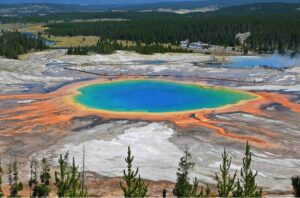This publication is in proud partnership with Project UNITY’s Catalyst Academy 2023 Summer Program.

Source: Pixabay, bertvthul
Why Ecotherapy
From Ayurvedic medicine to traditional Chinese medicine to modern Western medicine, nature has historically been linked to well-being1-4. Nature can renew one’s spirit, whether they are in a city park, a forest distant from civilization, or simply strolling along a street surrounded with trees. A quick stroll in nature can lower tension, keep one upbeat, and even enhance memory5. Furthermore, the act of simply glancing at images of greenery or being surrounded by nature, for less than a minute, can improve one’s attitude6.
These benefits of nature are intuitive – but recently researchers have been studying them more systematically. Their work has helped to justify and improve the practice of ecotherapy (or nature therapy), with great potential benefits for hospital patients, addressing mental health disorders, and improving the quality of everyday life.
The work of researchers provides more scientific support for these benefits of nature. One recent study explored how the mood changes during a nature walk using portable EEG (electroencephalography) sensors to measure brain activity. Portable EEG sensors allow researchers to monitor brain waves in real-time while subjects engage in various activities, such as walking in different environments. Researchers then discovered that when subjects were walking in a green area as opposed to a crowded commercial district or a busy retail street, their brain waves were more likely to resemble those of someone who is meditating7.
Others have studied the benefits of nature in a medical setting. One such study found that a patient recovering from gallbladder surgery healed more quickly when they had a window viewing nature than if they did not have one at all9. Additionally, those with a view of nature, through a window, reported less anxiety and recovered faster.
Ecotherapy can also treat mental health complications such as depression and anxiety. Findings from a pilot study on nature-based therapy for young psychosomatic patients support the broader concept of ecotherapy as a means to treat mental health complications such as depression and anxiety. The study demonstrated that engaging in nature-based therapy led to improvements in mental well-being, connectedness to nature, and a decrease in depression scores among participants. Thus, by combining outdoor exercise with the calming and restorative effects of nature, patients can reduce psychological symptoms and improve physical well-being by engaging in outdoor activities⁸.
Different Types of Ecotherapy
Ecotherapy can be performed through formal or informal approaches such as park prescriptions, animal-assisted therapy, and community farming. Walking, hiking, or simply unwinding in a park or other natural setting are all examples of informal approaches. Whereas formal methods typically involve the input of a medical professional. Park prescriptions involve doctors advising patients to spend time outside as part of their treatment plan. Animal-assisted therapy is when patients receive treatment with animals, such as dogs or horses. Being with animals in their natural environments can make people feel more at ease, less worried, emotionally attached, and reliable. Additionally, through community farming or gardening, individuals can work in the soil, cultivate their own food, and develop prosperous relationships with other accompanying peers. Altogether, these activities offer a sense of success and purpose and can promote social connections and a sense of belonging.
Ways to Include Ecotherapy into Daily Life
Integrating ecotherapy into everyday life and daily habits is a beneficial way to spend your free time. Some ways this can be done are by simply spending time outdoors, creating a nature corner in your home, or volunteering for environment initiatives. Establish a daily routine of going outside, even if it’s simply for a quick stroll around a nearby park or green space. Take breaks during the day to go outside, breathe in the fresh air, and become one with nature. Additionally, you can designate a section in your house or workplace where you can incorporate natural materials. To add a touch of nature to your immediate surroundings, you can set up potted plants, flowers, or tiny indoor gardens. You can also start taking part in local environmental initiatives or offering your time to organizations that are concerned with sustainability and conservation. Participating in initiatives like beach clean-ups, tree plantings, or wildlife conservation programs can help the environment while also allowing you to get the rewards of being outside.
Ecotherapy can be done anywhere. However, the key is to find ways to incorporate nature into your daily life that are approachable and enjoyable. With simple, consistent steps, the benefits of ecotherapy and more fulfilling relationships with nature can be achieved.
References
- Chopra, A. & Doiphode, V. V. Ayurvedic medicine vii (2002). Core concept, therapeutic principles, and current relevance. Med. Clin. North Am. 86, 75–89.
- Kayne, S. B. (2010). Traditional Medicine: A Global Perspective.
- Little, H., Elliott, S. & Wyver, S. (Routledge, 2020). Outdoor Learning Environments: Spaces for exploration, discovery and risk-taking in the early years.
- Buzzell, L. & Chalquist, C. (Counterpoint, 2009). Ecotherapy: Healing with Nature in Mind.
- Ulrich, R. S. (1991). Effects of interior design on wellness: theory and recent scientific research. J. Health Care Inter. Des. 3, 97–109.
- Brown, K. W., David Creswell, J. & Ryan, R. M.(Guilford Publications, 2015). Handbook of Mindfulness: Theory, Research, and Practice.
- Aspinall, R. & Gregory, P. (2013). Ecosystem services: nature’s balance sheet. Science vol. 342 421
- Joschko, L. (2023)”Nature-Based Therapy in Individuals with Mental Health Disorders, with a Focus on Mental Well-Being and Connectedness to Nature-a Pilot Study.”
- Ulrich, R. S.(1984) Viewing through a window may influence recovery from surgery. Science 224, 420–421
Related Posts
Early Childhood Adversity Impacts Impulsive Decision-Making
Cover Image: An image of a girl holding a stuffed...
Read MoreMedical Overtreatment in the United States: Causes, Consequences, and Solutions
This article was originally submitted to the Modern MD competition...
Read MoreRetitling Stress: A Look at the Yerkes-Dodson Law
Figure 1: This graph compares stress level with performance at...
Read MoreUnderstanding the Social Factors Affecting Cancer Therapy
Cover Image: A patient being prepared for radiation therapy. (Source:...
Read MoreRisk of Death Among Recently Released Inmates
Figure 1: While healthcare inequity is certainly an issue while...
Read MoreThermophilic Life in Yellowstone National Park Challenges the Physical and Chemical Limits of Survival
Cover Image: Grand Prismatic Spring in Yellowstone National Park (Source:...
Read MoreAamuktha Yalamanchili






